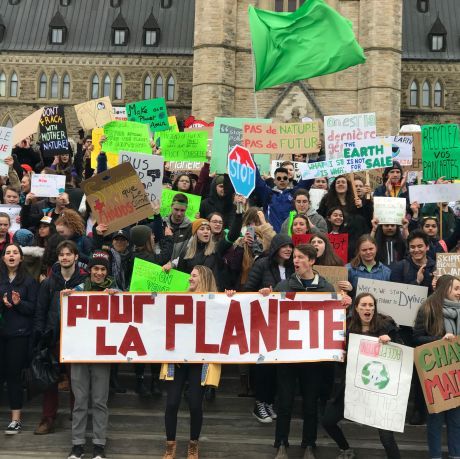News
You are here
Students strike for the climate!

March 16, 2019
More than a million students struck and protested across the globe on Friday calling for immediate action on climate change.
The wave of strikes were part of the “Fridays for the Future” movement led by students. There were more than 2000 actions in 123 countries.
It was a global day of action that began with students in Australia and New Zealand and moved westward across the world. In Australia, unions joined the students in demonstrations throughout the country. More than 150,000 marched in separate actions an all the major cities.
Actions erupted across Asia. In Delhi India students held placards saying “Breathing is killing us. We demand clean air, water and soils for our safe future.” In Gurgaon they marched behind a banner that read, “Rebel for the Future”.
And the wave continued to sweep towards Europe. Greta Thunburg, who started the Fridays for the Future demos when she struck on her own to protest climate chaos, marched in Stockholm Sweden.
She has become the face and voice of the movement which is growing at an incredible pace. Her speech to the global 1% in Davos has been watched millions of times.
“Some people say that the climate crisis is something that we all have created, but that is not true, because if everyone is guilty then no one is to blame. And someone is to blame. Some people, some companies, some decision-makers in particular, have known exactly what priceless values they have been sacrificing to continue making unimaginable amounts of money,” she said.
Europe
The actions in Europe were huge. There were more than 200 different actions in Germany. There were tens of thousands in Madrid and in other cities across the Spanish state. In the UK, more than 10,000 students converged in London and blocked roads. The protest in Paris also brought out more than 10,000.
Québec
Across Québec, well over 200,000 students struck in Universities, CEGEPs, and secondary and elementary schools. The Montréal school board was forced to suspend classes in some schools when younger students formed human chains in front of the doors. In Montreal, as many as 150,000 marched prompting many to say this hasn’t been seen since the Quebec student strikes of 2012, which defeated a tuition hike and brought down a government.
What was true in 2012 and still is today is that while the student movement is largest and strongest in Montreal, it is visible across Québec. In Gatineau around 700 students chanted, “So so so! Sauvons la planète !” before marching to Parliament Hill to converge with a smaller group from the University of Ottawa and Carleton. The rally was almost all in French except for the Indigenous speakers who spoke both in English and in their own languages. When they spoke, and each time the Indigenous Ottawa Riversingers performed, all the students spontaneously sat down silently on the ground and raised their fists in the air.
Some Quebec students are using similar tactics to those used in 2012. At the Université du Québec en Outaouais campus in Gatineau, social science students first voted to strike in their own faculty and then collected enough signatures to call a general assembly where a university-wide strike vote could be held. They got quorum at the assembly and won the strike vote. The strike movement in Quebec was called under the umbrella of “La Planète s’invite à l’Université" (“The Planet invites itself to University”) which has organized some huge marches in the last year ion Montreal; but for March 15 it was up to students themselves to build support in their own locales, with great success.
Ontario
In Toronto, hundreds converged on Queens park. Socialist worker asked them why they were out today, “I want a future to grow up in. I think what we are doing to our earth doesn't just effect us. It is important to make it clear that we are not okay with that it is not okay for the animals, the planet and the ecosystem. I hate climate change I think it deserves to be stopped. I am also here because of Wet'suwet'en and the pipeline. That's not so much about Ford, but I am not going to be able to protest Trudeau in Ottawa any time soon, so I'm here.”
As in Toronto, most Canadian demonstrations targeted the tar sands and the Trudeau government for pushing pipelines while calling himself a climate leader. Indigenous leaders spoke to rallies of thousands in Victoria and Halifax to call for reconciliation and indigenous sovereignty as well as action on climate change.
This was not the beginning of this movement nor is it the end. Students all over the world are planning to join demonstrations each month in escalating actions until their demands are met.
Section:
Topics:










